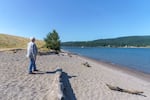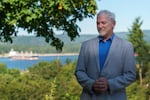Two boats sat anchored in the Columbia River, visible from the panoramic view in Mike Reuter’s living room.
A large ship rested upstream, waiting to berth at the Port of Kalama. Reuter, the town’s mayor, guessed it planned to haul away some of the port’s vast grain stores.
Downriver sat a small cruise ship. It floats tourists from riverside town to riverside town. It docked near Kalama’s new McMenamins hotel and restaurant. It was the port that made both possible, Reuter said.

Kalama Mayor Mike Reuter walks on a beach on the lower Columbia River, July 29, 2021. The area on the left is the site of a proposed $2 billion plant that would convert fracked natural gas into methanol, but developers have since pulled out of the deal.
Kristyna Wentz-Graff / OPB
“They’re making an investment,” he said of the port. He said he had to give them credit even if their relationship had strained.
For years, a massive methanol plant proposed in Kalama, and backed by port officials, had created fault lines in the community. It pitted neighbors against each other over what they prioritized more: the environment or the local economy.
Washington regulators denied a key permit for the project in January. The project, regulators said, would have been one of the top greenhouse gas emitters in the state.
Investors walked away after seven years. In June, they ended their port lease and cleared out their offices. Like cleaning a whiteboard, the future of 200 acres of riverside land quickly became unwritten again.
Reuter and others who stood against the plant got what they wanted. They staved off a heavy industrial use and the ecological questions it raised. But many who said they want to see Cowlitz County play to its blue-collar strengths still want to land a big industrial user.
Whatever follows will set the tone for Kalama’s economic future.
The mayor against methanol
Reuter, who is seeking his second term in November, will undoubtedly scrutinize any future plans for the former methanol site. He’s watched energy projects falter there time and again.
Two years after he moved to Kalama in 2005, a company tried to build a $1.5 billion fossil fuels plant there. The plant would have turned coal into gas, then burned the gas to generate power. It faltered quickly.
In 2010, the same company reappeared to pitch a $400 million natural gas plant. Like the previous idea, the company promised jobs. It lasted three years in development before it aborted, too.
So when the methanol idea took hold, Reuter decided to run for mayor. An office repair technician by trade, he was more comfortable fixing copy machines than debating global energy supply chains. But his campaigning saw The Daily News in Longview dub him a “one-man crusade” against the project.

Mike Reuter, mayor of Kalama, at his home overlooking the lower Columbia River, July 29, 2021. Reuter was one of the few elected opponents to building a $2 billion methanol plant on the river that would convert fracked natural gas into methanol.
Kristyna Wentz-Graff / OPB
Reuter was never alone, however, just the most visible. He sought political office to give himself a platform, he said, to steer his community from what he considered to be bad deals.
“Everyone was depending on a white knight, riding through town and giving everybody money to fix all their woes,” he said of the large industrial projects.
Had it been built, the methanol plant would have become one of the world’s largest. It would have turned fracked natural gas from Canada into methanol, a chemical compound that can be used to make plastics or be burned for fuel.
Investors said they were willing to spend $2 billion building the facility. It would have generated 1,400 construction jobs and 200 permanent jobs, they said. Beaucoup property taxes would be stuffed into schools, road funds and even the cemetery district.
Cowlitz County Fire District No. 5 penciled its budget to double, said Fire Chief Vic Leatzow. And investors promised an extra $1 million sweetener for the district to prepare for any fires at the plant. Leatzow said he’s understaffed and needs a new firehouse.
“When a big employer — regardless of whether it’s methanol or lithium-ion battery manufacturing — you see a big employer come in and it’s a little bit of a bright spot,” he said.
Cowlitz County has long been married to its image of a company town. Lumber jobs have dwindled, but Timber Unity posters still deck companies’ cyclone fences in industrial areas. Aluminum smelting once thrived there as well.
“I think the most difficult part of Cowlitz County in general is they want a person to come here with the promises of thousands of jobs, billions of dollars in investment,” Reuter said.
The big promises rarely become more.

Industrial sites near the Port of Kalama.
Kristyna Wentz-Graff / OPB
Relatively little investment has occurred in rural, western Washington, state economists said. Urban areas have grown significantly since the 2008 recession, yet Cowlitz County has seen just 4% job growth in a dozen years.
“That’s not much,” regional economist Scott Bailey said. “They’ve barely recovered. It’s these nonmetro areas in the western part of the state where it’s tough to find new investment.”
To Reuter, the path forward is to diversify. He pointed to the McMenamins Harbor Lodge. The eclectic restaurant chain spent an estimated $9 million to build the four-story, 30,000-foot lodge near the river. It opened in 2018, staffs dozens of people and draws day visitors and overnight guests.
He acknowledged the workers in the area and the infrastructure already built make it harder to recruit, say, a software company. “It’s easier to wait for one person – one methanol (plant), one coal terminal, one oil terminal.”
A blank slate
It’s a short walk from the lodge to the offices that once housed Northwest Innovation Works, the methanol plant’s investors. The river slides right past.
Standing on the neatly paved path, Ted Sprague pointed out how quickly the new, catchy waterfront blends away and becomes a commercial hub, with the river as its highway.
“While this part of the port is gorgeous, and very tourism and family friendly,” he said, then gestured upstream, past a curtain of trees, “the north part is very industrial.”
As president of the Cowlitz Economic Development Council, Sprague will have a major role in finding the next candidate for the former proposed methanol site. He rattled off a list of enterprises already beyond the trees: manufacturers of steel, glass and chemicals and a lumber company.
“And — north of that — would have been the methanol facility,” he said.
Word traveled fast when the methanol plant cut its lease. Sprague said his phone rang to life. Companies asked about the site, but worried about the state’s regulatory process.
“As you can imagine, there’s a lot of trepidation about being able to get a facility permitted,” Sprague said. He noted the methanol plant’s fate felt “like six years of work down the drain.”
While it’s true the methanol plant struggled to get permitted, its own greenhouse gas studies contributed to its demise. Judges in both Cowlitz County Superior Court and the U.S. District Court separately dealt blows by ruling the greenhouse gas studies insufficient. The rulings led to lost permits.
Sprague is eager to move on. He said he’s searching for the next contender. The plot of land remains “a perfect spot for a large manufacturer.”
Blue-collar jobs aren’t just local history to Sprague. Per capita, Cowlitz County has nearly double the manufacturing jobs than the average Washington county. Unlike other counties, its unemployment rate barely blipped when the pandemic shut down bars and restaurants.

Kalama straddles Interstate 5 about 40 miles north of Portland. Environmentalists and some residents want Cowlitz County to create more green infrastructure, just as Washington state is doing, instead of developing more industrial business on the lower Columbia River. July 28, 2021
Kristyna Wentz-Graff / OPB
With aluminum and lumber gone or waning, fossil fuels have been a natural courtship. Two propane terminals and a coal terminal each tried to set up shop in Longview over the past seven years. They, too, promised thousands of construction jobs and some permanent jobs.
Mike Bridges, the local electricians’ union representative, weathered a lot of disappointment when those projects failed to materialize.
“There would have been careers started in the trades,” he said. “It’s still hard to think about.”
Leaning into green industries might make more sense, Bridges said, as Washington and the United Sates push to clean their energy grids for the future.
In 2019, Washington lawmakers passed the Clean Energy Transformation Act, requiring power companies to stop generating electricity via carbon emissions and switch entirely over to wind, solar and the like by 2045.
The federal government’s $1.2 trillion infrastructure plan also carves out billions for projects like building more electric vehicle charging stations, battery technology, and building power lines to weave together the nation’s regional power grids.
Bridges pointed to an energy storage project in Klickitat County that uses a closed loop of hydropower to generate electricity. The project is currently under review.
“A lot of that technology is going to take a little bit longer. We want to make sure we don’t say no to projects that can be a transitional project (away from greenhouse gases),” he said. “We gotta try to get a win here.”
Sprague couldn’t name the companies who’ve called to discuss the former methanol property. He cited nondisclosure agreements he signed. But he spoke generally of a manufacturer of wood pellets — a purported coal replacement — a semiconductor manufacturer and data centers.
“We’re open to all of it — as long as you can get it permitted,” he said.

McMenamins Kalama Harbor Lodge opened in 2018, developing an area of the Kalama waterfront for tourism. Kalama Mayor Mike Reuter would like to see the waterfront support more green infrastructure jobs.
Kristyna Wentz-Graff / OPB
Even if the county lassoed a biofuel refinery or another so-called clean energy company, Sprague said some in the community would still fight it. Conflict seemed inevitable.
“It doesn’t matter what the industry is, if it’s solar panels or wind turbines or whatever, it’s going to be difficult,” he said. “There’s a constituency that feels like the Columbia River should look like it did when Lewis and Clark paddled through it.”
Reuter worried about more division, too. Stumping for his second mayoral term, he said the big projects gin up an Election Day-like animosity, with neighbors planting dueling yard signs.
Except, Reuter said, elections only last months. Big projects take years.
“It would be like having a seven-year election process,” he said. “It does have effects on your relationships with people.”